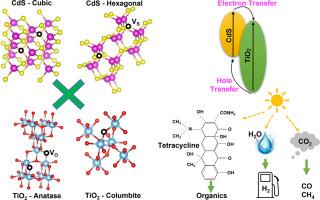High-pressure phase and dual sulfur-oxygen vacancy induction in CdS-TiO2 heterojunctions for multifunctional photocatalytic applications
IF 9.3
1区 材料科学
Q1 MATERIALS SCIENCE, MULTIDISCIPLINARY
引用次数: 0
Abstract
The discovery of visible-light-active photocatalysts that operate without noble-metal co-catalysts remains a major bottleneck for environmental remediation and sustainable energy conversion. In the current investigation, a CdS-TiO2 heterojunction is synthesized via a high-pressure torsion process at ambient temperature, integrating multiple beneficial features for photocatalysis: a high-pressure TiO₂ columbite phase with enhanced surface activity, dual sulfur and oxygen vacancies that increase light absorption and provide catalytic sites, and multiphase heterojunctions that promote charge separation and suppress recombination. These structural advantages lead to outstanding photocatalytic performance across different key applications: (i) efficient tetracycline antibiotic degradation under visible light without a co-catalyst, (ii) hydrogen production without a co-catalyst, (iii) hydrogen generation at a rate five times higher than TiO2 with platinum co-catalyst addition, and (iv) CO2 photoreduction with an activity 38 times greater than TiO2 without co-catalyst. These results highlight dual-vacancy formation and high-pressure phase incorporation in heterostructured catalysts as an effective strategy for designing multifunctional, stable and low-band-gap photocatalysts for environmental and energy-related applications.


高压相和双硫氧空位诱导CdS-TiO2异质结在多功能光催化中的应用
没有贵金属辅助催化剂的可见光活性光催化剂的发现仍然是环境修复和可持续能源转化的主要瓶颈。在本研究中,我们在室温下通过高压扭转工艺合成了CdS-TiO2异质结,该异质结整合了多种有利于光催化的特性:表面活性增强的高压tio2柱状相,增加光吸收并提供催化位点的双硫和双氧空位,以及促进电荷分离和抑制重组的多相异质结。这些结构优势使其在不同的关键应用中具有出色的光催化性能:(i)在可见光下无助催化剂的高效四环素抗生素降解,(ii)无助催化剂的31.5 μmol g-1产氢,(iii)添加铂助催化剂的产氢速率是TiO2的5倍,(iv) CO2光还原活性是TiO2的38倍。这些结果表明,在异质结构催化剂中形成双空位和高压相结合是设计多功能、稳定和低带隙光催化剂的有效策略,可用于环境和能源相关应用。
本文章由计算机程序翻译,如有差异,请以英文原文为准。
求助全文
约1分钟内获得全文
求助全文
来源期刊

Acta Materialia
工程技术-材料科学:综合
CiteScore
16.10
自引率
8.50%
发文量
801
审稿时长
53 days
期刊介绍:
Acta Materialia serves as a platform for publishing full-length, original papers and commissioned overviews that contribute to a profound understanding of the correlation between the processing, structure, and properties of inorganic materials. The journal seeks papers with high impact potential or those that significantly propel the field forward. The scope includes the atomic and molecular arrangements, chemical and electronic structures, and microstructure of materials, focusing on their mechanical or functional behavior across all length scales, including nanostructures.
 求助内容:
求助内容: 应助结果提醒方式:
应助结果提醒方式:


